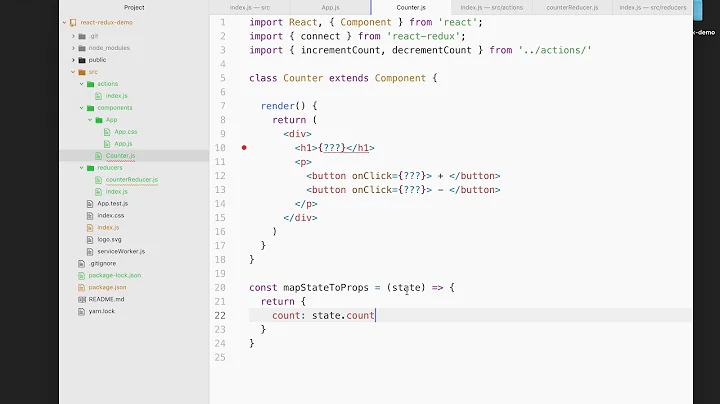What's the '@' (at symbol) in the Redux @connect decorator?
Solution 1
The @ symbol is in fact a JavaScript expression currently proposed to signify decorators:
Decorators make it possible to annotate and modify classes and properties at design time.
Here's an example of setting up Redux without and with a decorator:
Without a decorator
import React from 'react';
import * as actionCreators from './actionCreators';
import { bindActionCreators } from 'redux';
import { connect } from 'react-redux';
function mapStateToProps(state) {
return { todos: state.todos };
}
function mapDispatchToProps(dispatch) {
return { actions: bindActionCreators(actionCreators, dispatch) };
}
class MyApp extends React.Component {
// ...define your main app here
}
export default connect(mapStateToProps, mapDispatchToProps)(MyApp);
Using a decorator
import React from 'react';
import * as actionCreators from './actionCreators';
import { bindActionCreators } from 'redux';
import { connect } from 'react-redux';
function mapStateToProps(state) {
return { todos: state.todos };
}
function mapDispatchToProps(dispatch) {
return { actions: bindActionCreators(actionCreators, dispatch) };
}
@connect(mapStateToProps, mapDispatchToProps)
export default class MyApp extends React.Component {
// ...define your main app here
}
Both examples above are equivalent, it's just a matter of preference. Also, the decorator syntax isn't built into any Javascript runtimes yet, and is still experimental and subject to change. If you want to use it, it is available using Babel.
Solution 2
Very Important!
These props are called state props and they are different from normal props, any change to your component state props will trigger the component render method again and again even if you don't use these props so for Performance Reasons try to bind to your component only the state props that you need inside your component and if you use a sub props only bind these props.
example: lets say inside your component you only need two props:
- the last message
- the user name
don't do this
@connect(state => ({
user: state.user,
messages: state.messages
}))
do this
@connect(state => ({
user_name: state.user.name,
last_message: state.messages[state.messages.length-1]
}))
Related videos on Youtube
Salman
Updated on August 12, 2020Comments
-
Salman almost 4 years
I am learning Redux with React and stumbled upon this code. I am not sure if it is Redux specific or not, but I have seen the following code snippet in one of the examples.
@connect((state) => { return { key: state.a.b }; })While the functionality of
connectis pretty straightforward, but I don't understand the@beforeconnect. It isn't even a JavaScript operator if I am not wrong.Can someone explain please what is this and why is it used?
Update:
It is in fact a part of
react-reduxwhich is used to connects a React component to a Redux store.-
Lee over 8 yearsI'm not familiar with Redux, but it looks like a decorator. medium.com/google-developers/…
-
 MK. over 7 yearsI love how in this new JavaScript world you are staring at the code half of the time and thinking "what part of the language syntax is this?"
MK. over 7 yearsI love how in this new JavaScript world you are staring at the code half of the time and thinking "what part of the language syntax is this?" -
Salman over 7 yearsLol, I'm way deep into redux and stuff now. But back then I didn't know the decorator syntax has nothing to do with redux. Its just JavaScript. Glad to see this question is helping a lot of people like me. :)
-
 Syed Jafri over 7 yearsApparently the redux team discourages the use of connect as a decorator at the moment github.com/happypoulp/redux-tutorial/issues/87
Syed Jafri over 7 yearsApparently the redux team discourages the use of connect as a decorator at the moment github.com/happypoulp/redux-tutorial/issues/87
-
-
LessQuesar over 7 yearsOne can even be more terse with ES6 syntax. @connect( state => { return { todos: state.todos }; }, dispatch => { return {actions: bindActionCreators(actionCreators, dispatch)}; } )
-
Tanner Semerad over 7 yearsIf you really want to be terse you can use implicit returns in ES6. It depends on how explicit you want to be.
@connect(state => ({todos: state.todos}), dispatch => ({actions: bindActionCreators(actionCreators, dispatch)})) -
 tim about 7 yearsHow would you export the unconnected component for unit testing?
tim about 7 yearsHow would you export the unconnected component for unit testing? -
straya about 7 yearsUsing decorator for redux with react-navigation can be problematic, current best-practice is to use the function not the decorator: github.com/react-community/react-navigation/issues/1180
-
Julius Koronci almost 7 yearsor use selectors like reselect or fastmemoize
-
zloctb over 6 years
-
 Subhadeep Banerjee almost 6 yearsThe examples are really helpful
Subhadeep Banerjee almost 6 yearsThe examples are really helpful -
vsync over 5 yearsWhat does this mean
"at design time"? Never heard this term design time. can you explain it? -
serg06 about 2 yearsIs this possible with functional components?












